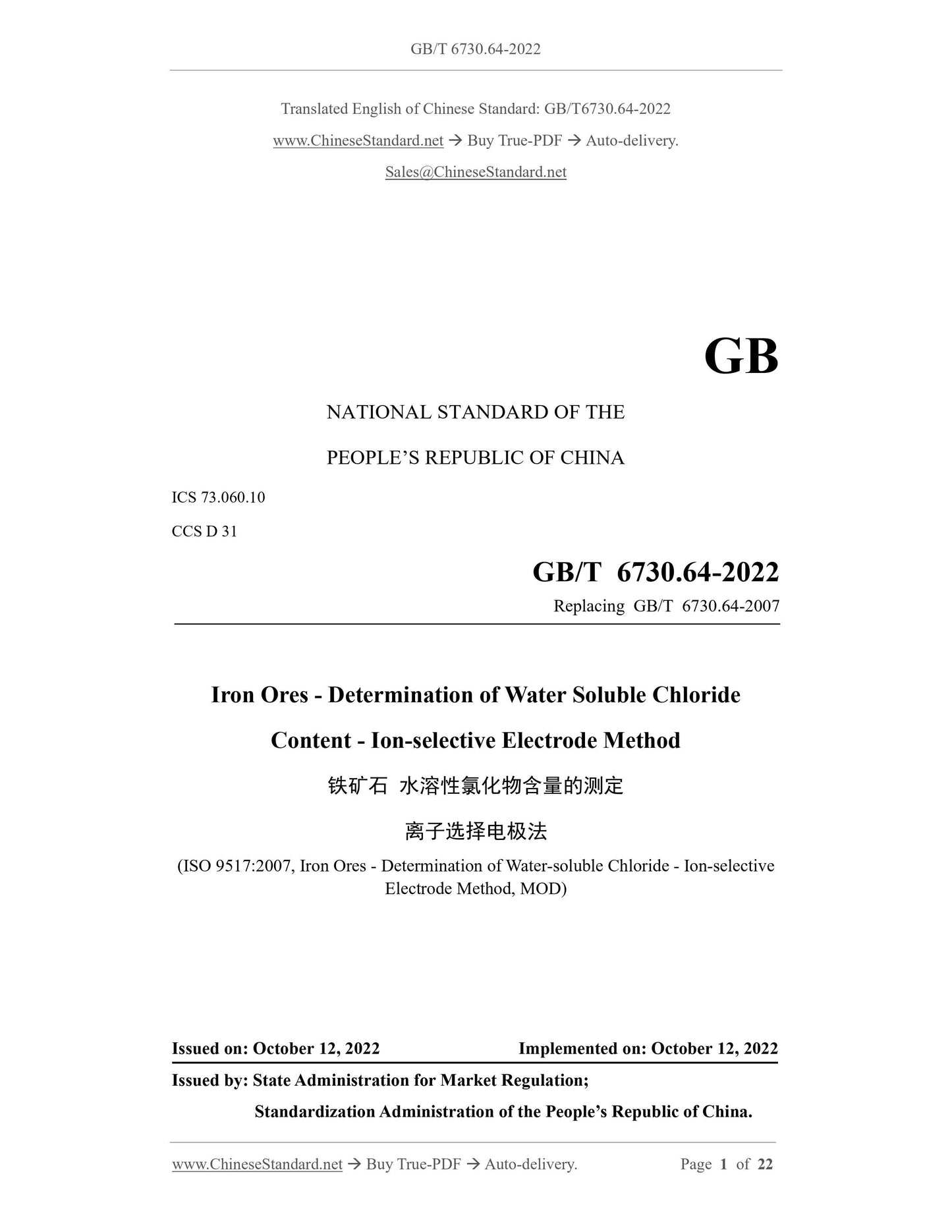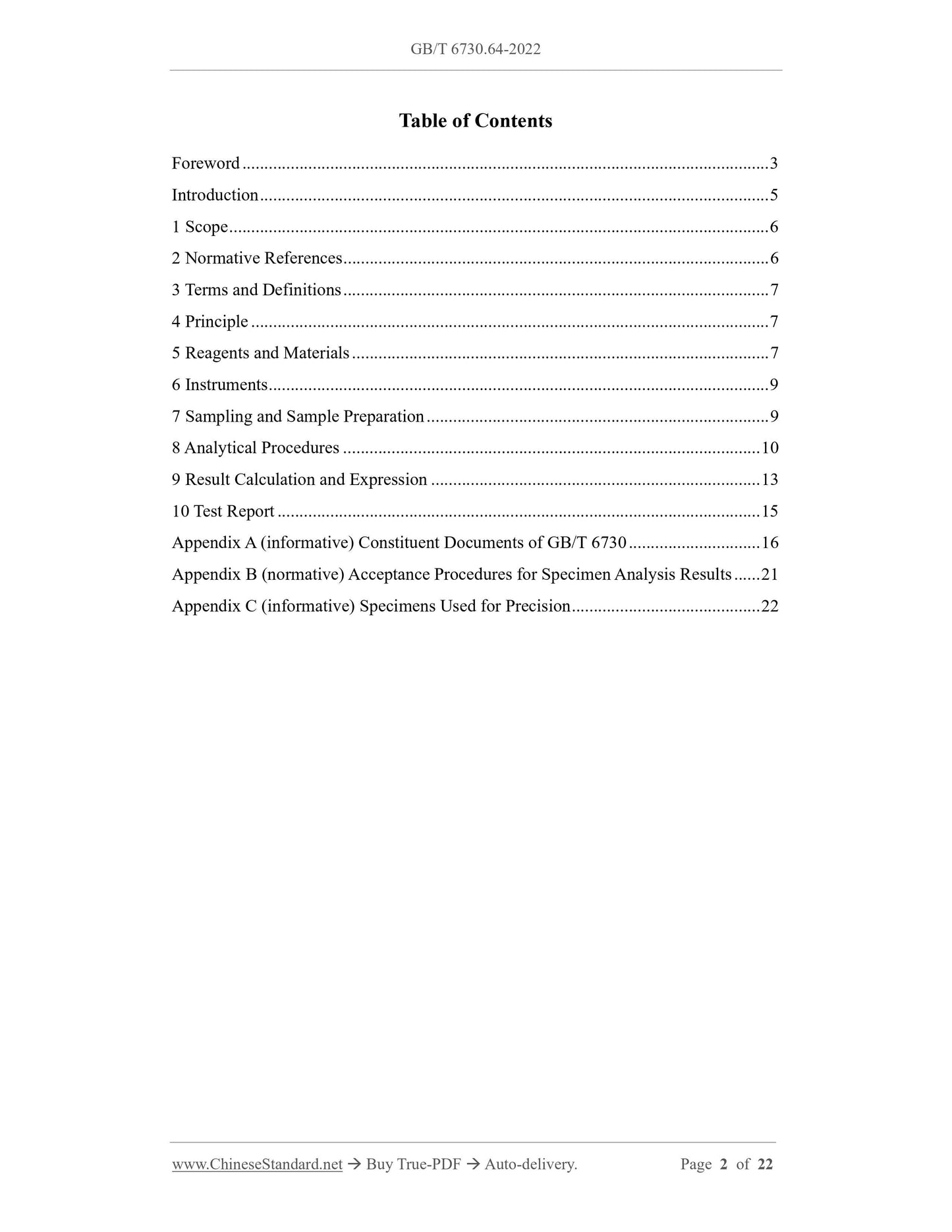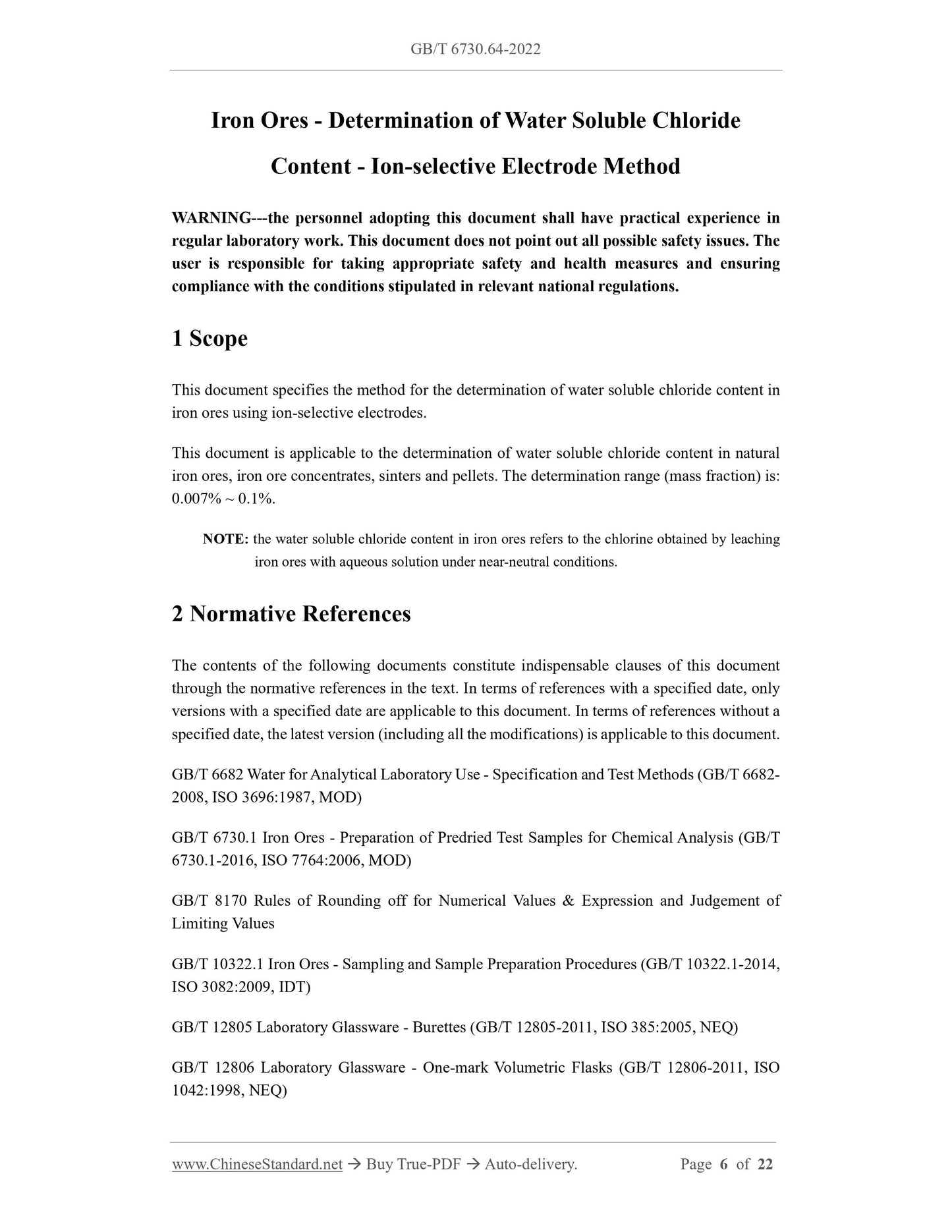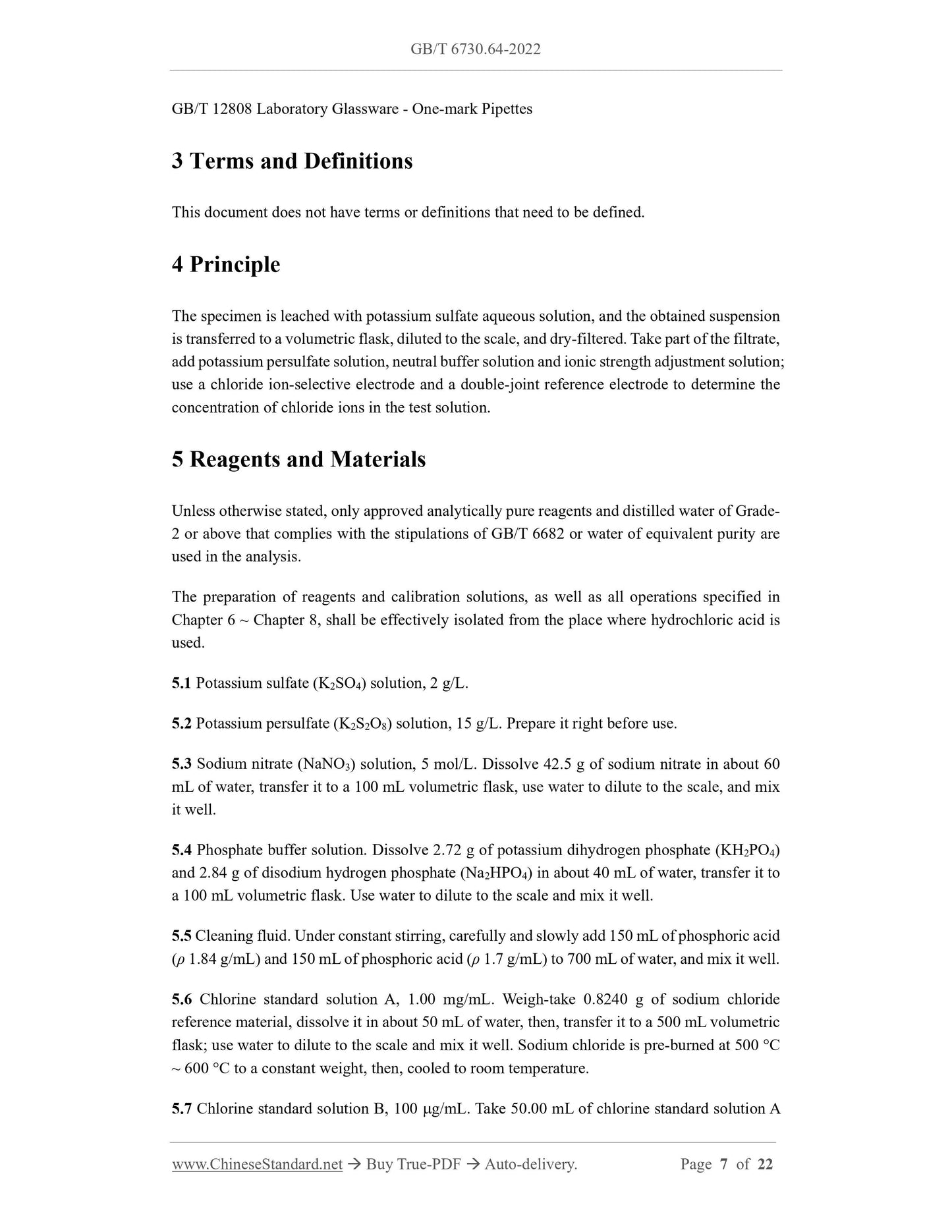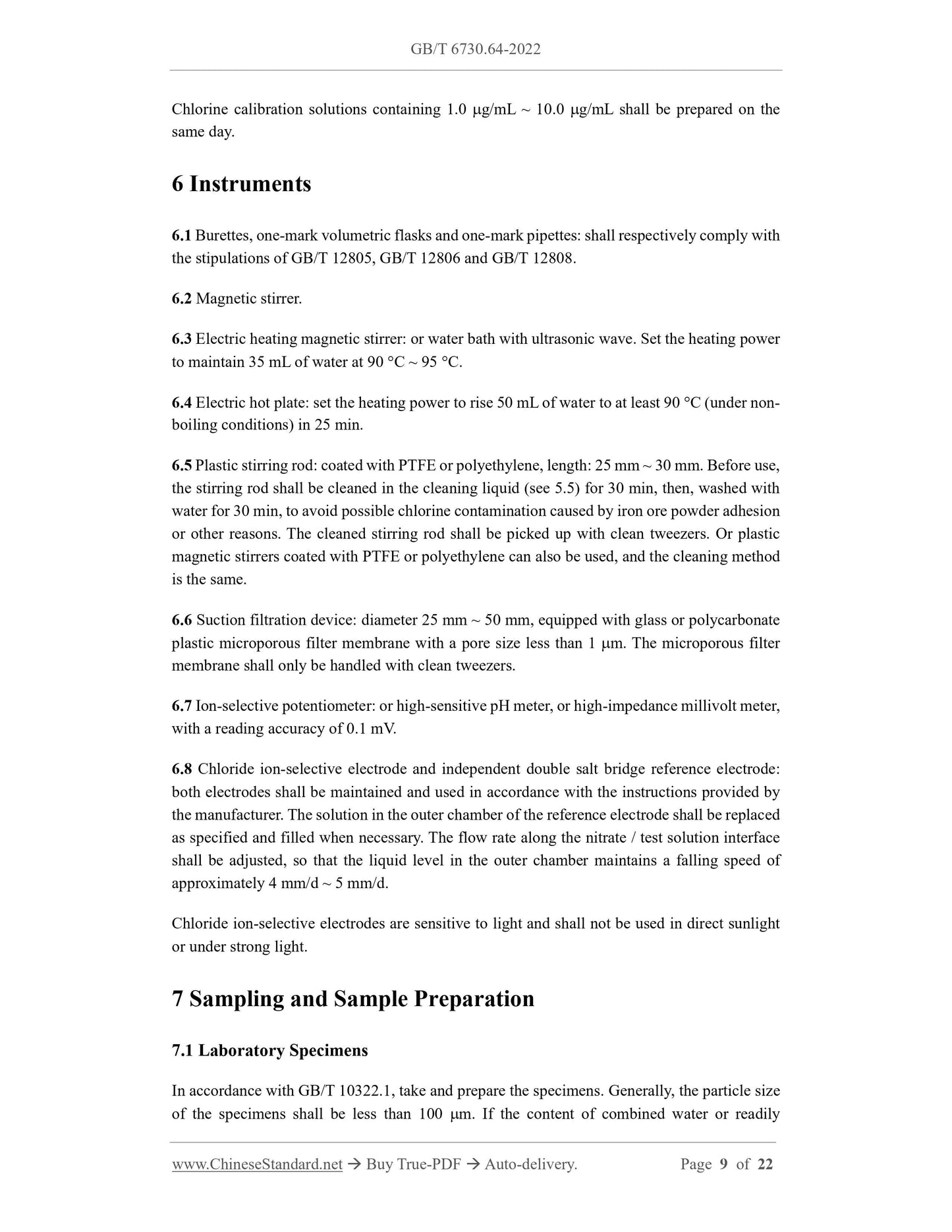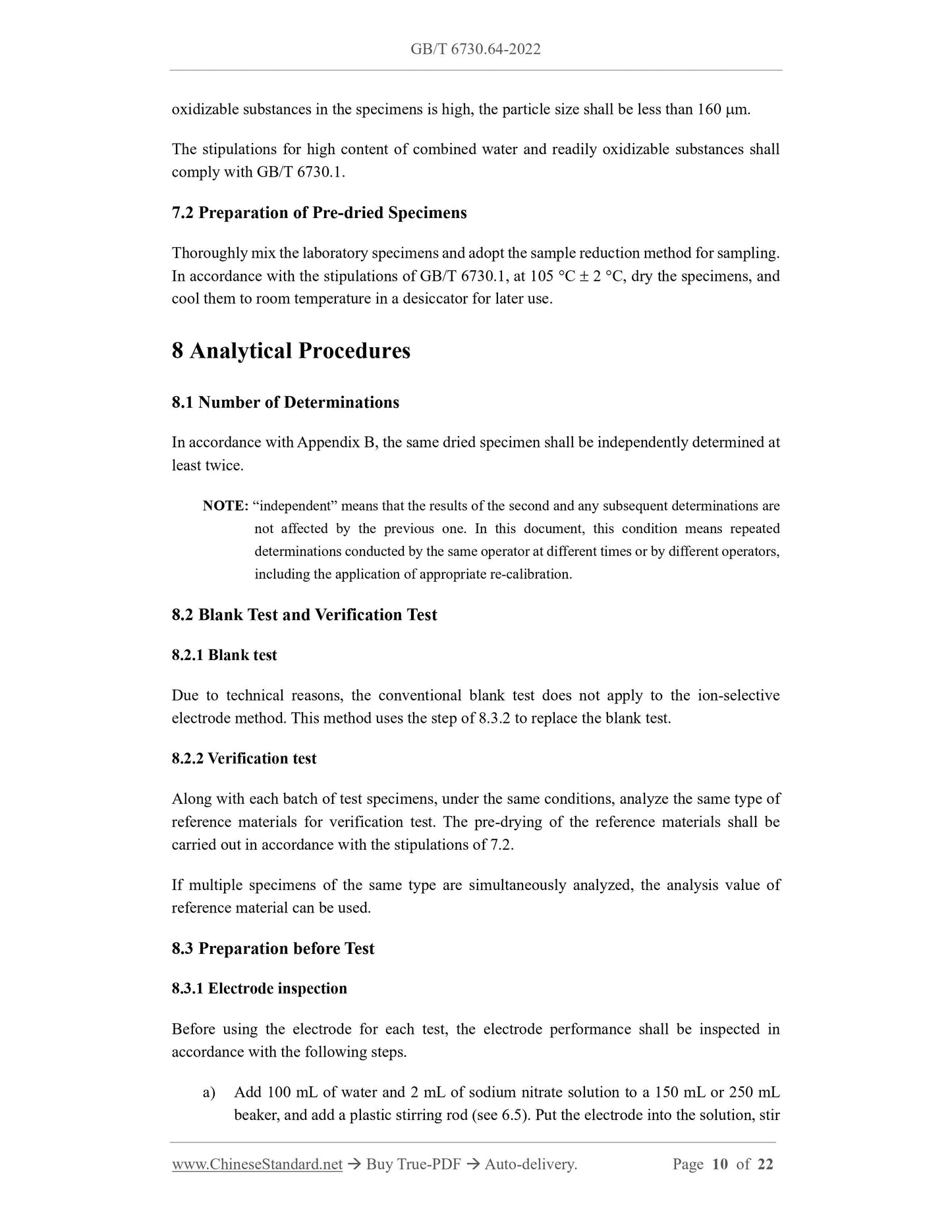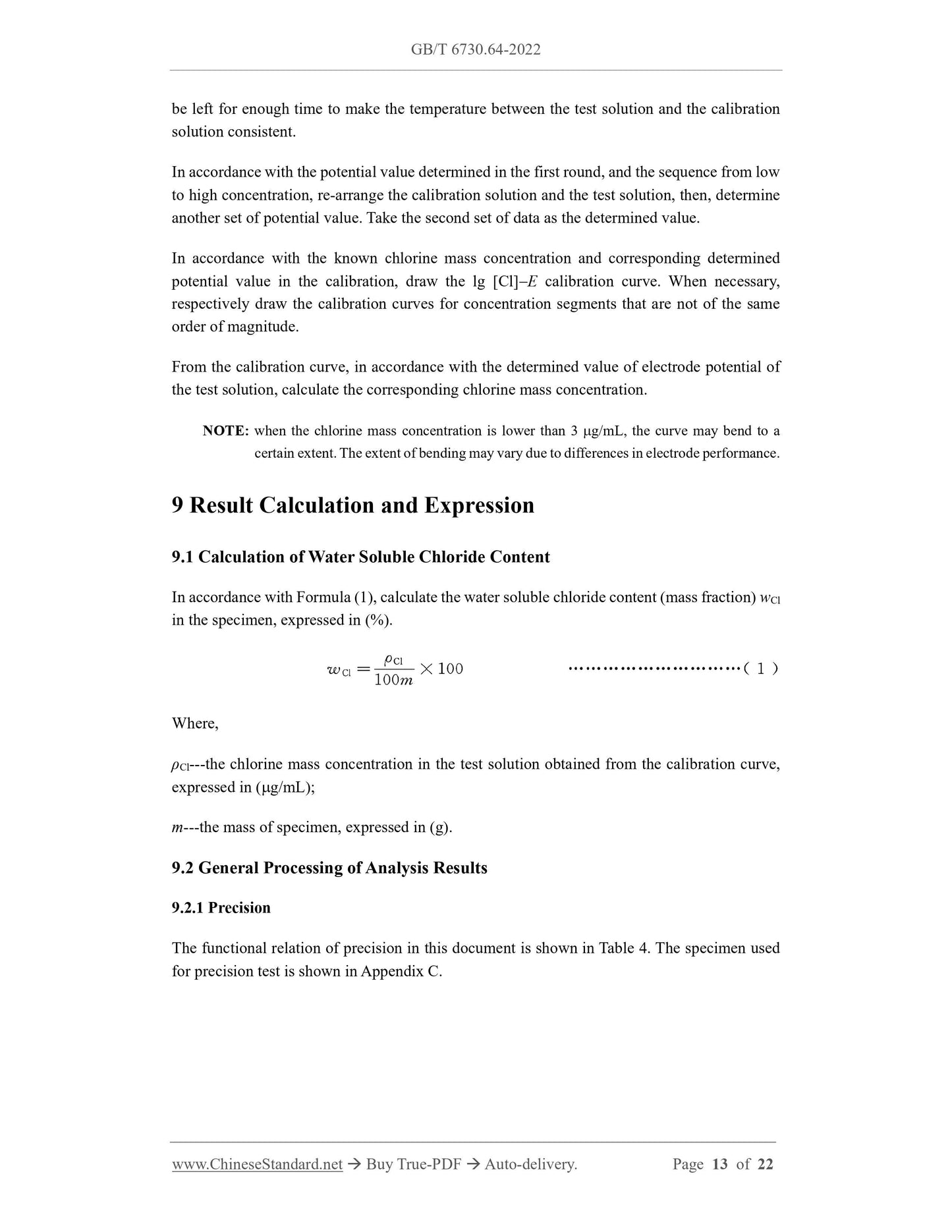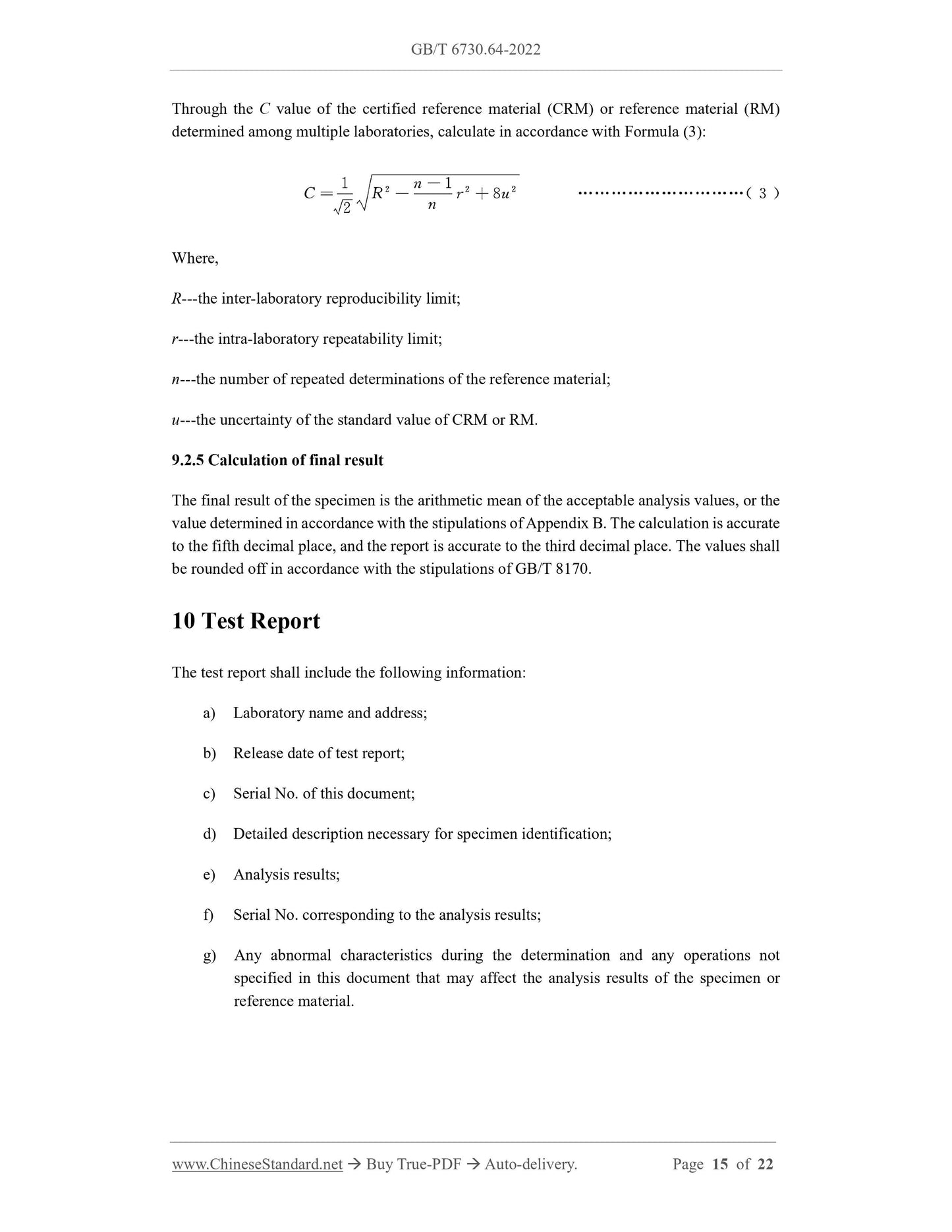PayPal, credit cards. Download editable-PDF and invoice in 1 second!
GB/T 6730.64-2022 English PDF (GBT6730.64-2022)
GB/T 6730.64-2022 English PDF (GBT6730.64-2022)
Precio habitual
$230.00 USD
Precio habitual
Precio de oferta
$230.00 USD
Precio unitario
/
por
Los gastos de envío se calculan en la pantalla de pago.
No se pudo cargar la disponibilidad de retiro
Delivery: 3 seconds. Download true-PDF + Invoice.
Get QUOTATION in 1-minute: Click GB/T 6730.64-2022
Historical versions: GB/T 6730.64-2022
Preview True-PDF (Reload/Scroll if blank)
GB/T 6730.64-2022: Iron ores -- Determination of water soluble chloride content -- Ion-selective electrode method
GB/T 6730.64-2022
GB
NATIONAL STANDARD OF THE
PEOPLE’S REPUBLIC OF CHINA
ICS 73.060.10
CCS D 31
Replacing GB/T 6730.64-2007
Iron Ores - Determination of Water Soluble Chloride
Content - Ion-selective Electrode Method
(ISO 9517:2007, Iron Ores - Determination of Water-soluble Chloride - Ion-selective
Electrode Method, MOD)
ISSUED ON: OCTOBER 12, 2022
IMPLEMENTED ON: OCTOBER 12, 2022
Issued by: State Administration for Market Regulation;
Standardization Administration of the People’s Republic of China.
Table of Contents
Foreword ... 3
Introduction ... 5
1 Scope ... 6
2 Normative References ... 6
3 Terms and Definitions ... 7
4 Principle ... 7
5 Reagents and Materials ... 7
6 Instruments ... 9
7 Sampling and Sample Preparation ... 9
8 Analytical Procedures ... 10
9 Result Calculation and Expression ... 13
10 Test Report ... 15
Appendix A (informative) Constituent Documents of GB/T 6730 ... 16
Appendix B (normative) Acceptance Procedures for Specimen Analysis Results ... 21
Appendix C (informative) Specimens Used for Precision ... 22
Iron Ores - Determination of Water Soluble Chloride
Content - Ion-selective Electrode Method
WARNING---the personnel adopting this document shall have practical experience in
regular laboratory work. This document does not point out all possible safety issues. The
user is responsible for taking appropriate safety and health measures and ensuring
compliance with the conditions stipulated in relevant national regulations.
1 Scope
This document specifies the method for the determination of water soluble chloride content in
iron ores using ion-selective electrodes.
This document is applicable to the determination of water soluble chloride content in natural
iron ores, iron ore concentrates, sinters and pellets. The determination range (mass fraction) is:
0.007% ~ 0.1%.
NOTE: the water soluble chloride content in iron ores refers to the chlorine obtained by leaching
iron ores with aqueous solution under near-neutral conditions.
2 Normative References
The contents of the following documents constitute indispensable clauses of this document
through the normative references in the text. In terms of references with a specified date, only
versions with a specified date are applicable to this document. In terms of references without a
specified date, the latest version (including all the modifications) is applicable to this document.
GB/T 6682 Water for Analytical Laboratory Use - Specification and Test Methods (GB/T 6682-
2008, ISO 3696:1987, MOD)
GB/T 6730.1 Iron Ores - Preparation of Predried Test Samples for Chemical Analysis (GB/T
6730.1-2016, ISO 7764:2006, MOD)
GB/T 8170 Rules of Rounding off for Numerical Values and Expression and Judgement of
Limiting Values
GB/T 10322.1 Iron Ores - Sampling and Sample Preparation Procedures (GB/T 10322.1-2014,
ISO 3082:2009, IDT)
GB/T 12805 Laboratory Glassware - Burettes (GB/T 12805-2011, ISO 385:2005, NEQ)
GB/T 12806 Laboratory Glassware - One-mark Volumetric Flasks (GB/T 12806-2011, ISO
1042:1998, NEQ)
GB/T 12808 Laboratory Glassware - One-mark Pipettes
3 Terms and Definitions
This document does not have terms or definitions that need to be defined.
4 Principle
The specimen is leached with potassium sulfate aqueous solution, and the obtained suspension
is transferred to a volumetric flask, diluted to the scale, and dry-filtered. Take part of the filtrate,
add potassium persulfate solution, neutral buffer solution and ionic strength adjustment solution;
use a chloride ion-selective electrode and a double-joint reference electrode to determine the
concentration of chloride ions in the test solution.
5 Reagents and Materials
Unless otherwise stated, only approved analytically pure reagents and distilled water of Grade-
2 or above that complies with the stipulations of GB/T 6682 or water of equivalent purity are
used in the analysis.
The preparation of reagents and calibration solutions, as well as all operations specified in
Chapter 6 ~ Chapter 8, shall be effectively isolated from the place where hydrochloric acid is
used.
5.1 Potassium sulfate (K2SO4) solution, 2 g/L.
5.2 Potassium persulfate (K2S2O8) solution, 15 g/L. Prepare it right before use.
5.3 Sodium nitrate (NaNO3) solution, 5 mol/L. Dissolve 42.5 g of sodium nitrate in about 60
mL of water, transfer it to a 100 mL volumetric flask, use water to dilute to the scale, and mix
it well.
5.4 Phosphate buffer solution. Dissolve 2.72 g of potassium dihydrogen phosphate (KH2PO4)
and 2.84 g of disodium hydrogen phosphate (Na2HPO4) in about 40 mL of water, transfer it to
a 100 mL volumetric flask. Use water to dilute to the scale and mix it well.
5.5 Cleaning fluid. Under constant stirring, carefully and slowly add 150 mL of phosphoric acid
(ρ 1.84 g/mL) and 150 mL of phosphoric acid (ρ 1.7 g/mL) to 700 mL of water, and mix it well.
5.6 Chlorine standard solution A, 1.00 mg/mL. Weigh-take 0.8240 g of sodium chloride
reference material, dissolve it in about 50 mL of water, then, transfer it to a 500 mL volumetric
flask; use water to dilute to the scale and mix it well. Sodium chloride is pre-burned at 500 C
~ 600 C to a constant weight, then, cooled to room temperature.
5.7 Chlorine standard solution B, 100 g/mL. Take 50.00 mL of chlorine standard solution A
Chlorine calibration solutions containing 1.0 g/mL ~ 10.0 g/mL shall be prepared on the
same day.
6 Instruments
6.1 Burettes, one-mark volumetric flasks and one-mark pipettes: shall respectively comply with
the stipulations of GB/T 12805, GB/T 12806 and GB/T 12808.
6.2 Magnetic stirrer.
6.3 Electric heating magnetic stirrer: or water bath with ultrasonic wave. Set the heating power
to maintain 35 mL of water at 90 C ~ 95 C.
6.4 Electric hot plate: set the heating power to rise 50 mL of water to at least 90 C (under non-
boiling conditions) in 25 min.
6.5 Plastic stirring rod: coated with PTFE or polyethylene, length: 25 mm ~ 30 mm. Before use,
the stirring rod shall be cleaned in the cleaning liquid (see 5.5) for 30 min, then, washed with
water for 30 min, to avoid possible chlorine contamination caused by iron ore powder adhesion
or other reasons. The cleaned stirring rod shall be picked up with clean tweezers. Or plastic
magnetic stirrers coated with PTFE or polyethylene can also be used, and the cleaning method
is the same.
6.6 Suction filtration device: diameter 25 mm ~ 50 mm, equipped with glass or polycarbonate
plastic microporous filter membrane with a pore size less than 1 m. The microporous filter
membrane shall only be handled with clean tweezers.
6.7 Ion-selective potentiometer: or high-sensitive pH meter, or high-impedance millivolt meter,
with a reading accuracy of 0.1 mV.
6.8 Chloride ion-selective electrode and independent double salt bridge reference electrode:
both electrodes shall be maintained and used in accordance with the instructions provided by
the manufacturer. The solution in the outer chamber of the reference electrode shall be replaced
as specified and filled when necessary. The flow rate along the nitrate / test solution interface
shall be adjusted, so that the liquid level in the outer chamber maintains a falling speed of
approximately 4 mm/d ~ 5 mm/d.
Chloride ion-selective electrodes are sensitive to light and shall not be used in direct sunlight
or under strong light.
7 Sampling and Sample Preparation
7.1 Laboratory Specimens
In accordance with...
Get QUOTATION in 1-minute: Click GB/T 6730.64-2022
Historical versions: GB/T 6730.64-2022
Preview True-PDF (Reload/Scroll if blank)
GB/T 6730.64-2022: Iron ores -- Determination of water soluble chloride content -- Ion-selective electrode method
GB/T 6730.64-2022
GB
NATIONAL STANDARD OF THE
PEOPLE’S REPUBLIC OF CHINA
ICS 73.060.10
CCS D 31
Replacing GB/T 6730.64-2007
Iron Ores - Determination of Water Soluble Chloride
Content - Ion-selective Electrode Method
(ISO 9517:2007, Iron Ores - Determination of Water-soluble Chloride - Ion-selective
Electrode Method, MOD)
ISSUED ON: OCTOBER 12, 2022
IMPLEMENTED ON: OCTOBER 12, 2022
Issued by: State Administration for Market Regulation;
Standardization Administration of the People’s Republic of China.
Table of Contents
Foreword ... 3
Introduction ... 5
1 Scope ... 6
2 Normative References ... 6
3 Terms and Definitions ... 7
4 Principle ... 7
5 Reagents and Materials ... 7
6 Instruments ... 9
7 Sampling and Sample Preparation ... 9
8 Analytical Procedures ... 10
9 Result Calculation and Expression ... 13
10 Test Report ... 15
Appendix A (informative) Constituent Documents of GB/T 6730 ... 16
Appendix B (normative) Acceptance Procedures for Specimen Analysis Results ... 21
Appendix C (informative) Specimens Used for Precision ... 22
Iron Ores - Determination of Water Soluble Chloride
Content - Ion-selective Electrode Method
WARNING---the personnel adopting this document shall have practical experience in
regular laboratory work. This document does not point out all possible safety issues. The
user is responsible for taking appropriate safety and health measures and ensuring
compliance with the conditions stipulated in relevant national regulations.
1 Scope
This document specifies the method for the determination of water soluble chloride content in
iron ores using ion-selective electrodes.
This document is applicable to the determination of water soluble chloride content in natural
iron ores, iron ore concentrates, sinters and pellets. The determination range (mass fraction) is:
0.007% ~ 0.1%.
NOTE: the water soluble chloride content in iron ores refers to the chlorine obtained by leaching
iron ores with aqueous solution under near-neutral conditions.
2 Normative References
The contents of the following documents constitute indispensable clauses of this document
through the normative references in the text. In terms of references with a specified date, only
versions with a specified date are applicable to this document. In terms of references without a
specified date, the latest version (including all the modifications) is applicable to this document.
GB/T 6682 Water for Analytical Laboratory Use - Specification and Test Methods (GB/T 6682-
2008, ISO 3696:1987, MOD)
GB/T 6730.1 Iron Ores - Preparation of Predried Test Samples for Chemical Analysis (GB/T
6730.1-2016, ISO 7764:2006, MOD)
GB/T 8170 Rules of Rounding off for Numerical Values and Expression and Judgement of
Limiting Values
GB/T 10322.1 Iron Ores - Sampling and Sample Preparation Procedures (GB/T 10322.1-2014,
ISO 3082:2009, IDT)
GB/T 12805 Laboratory Glassware - Burettes (GB/T 12805-2011, ISO 385:2005, NEQ)
GB/T 12806 Laboratory Glassware - One-mark Volumetric Flasks (GB/T 12806-2011, ISO
1042:1998, NEQ)
GB/T 12808 Laboratory Glassware - One-mark Pipettes
3 Terms and Definitions
This document does not have terms or definitions that need to be defined.
4 Principle
The specimen is leached with potassium sulfate aqueous solution, and the obtained suspension
is transferred to a volumetric flask, diluted to the scale, and dry-filtered. Take part of the filtrate,
add potassium persulfate solution, neutral buffer solution and ionic strength adjustment solution;
use a chloride ion-selective electrode and a double-joint reference electrode to determine the
concentration of chloride ions in the test solution.
5 Reagents and Materials
Unless otherwise stated, only approved analytically pure reagents and distilled water of Grade-
2 or above that complies with the stipulations of GB/T 6682 or water of equivalent purity are
used in the analysis.
The preparation of reagents and calibration solutions, as well as all operations specified in
Chapter 6 ~ Chapter 8, shall be effectively isolated from the place where hydrochloric acid is
used.
5.1 Potassium sulfate (K2SO4) solution, 2 g/L.
5.2 Potassium persulfate (K2S2O8) solution, 15 g/L. Prepare it right before use.
5.3 Sodium nitrate (NaNO3) solution, 5 mol/L. Dissolve 42.5 g of sodium nitrate in about 60
mL of water, transfer it to a 100 mL volumetric flask, use water to dilute to the scale, and mix
it well.
5.4 Phosphate buffer solution. Dissolve 2.72 g of potassium dihydrogen phosphate (KH2PO4)
and 2.84 g of disodium hydrogen phosphate (Na2HPO4) in about 40 mL of water, transfer it to
a 100 mL volumetric flask. Use water to dilute to the scale and mix it well.
5.5 Cleaning fluid. Under constant stirring, carefully and slowly add 150 mL of phosphoric acid
(ρ 1.84 g/mL) and 150 mL of phosphoric acid (ρ 1.7 g/mL) to 700 mL of water, and mix it well.
5.6 Chlorine standard solution A, 1.00 mg/mL. Weigh-take 0.8240 g of sodium chloride
reference material, dissolve it in about 50 mL of water, then, transfer it to a 500 mL volumetric
flask; use water to dilute to the scale and mix it well. Sodium chloride is pre-burned at 500 C
~ 600 C to a constant weight, then, cooled to room temperature.
5.7 Chlorine standard solution B, 100 g/mL. Take 50.00 mL of chlorine standard solution A
Chlorine calibration solutions containing 1.0 g/mL ~ 10.0 g/mL shall be prepared on the
same day.
6 Instruments
6.1 Burettes, one-mark volumetric flasks and one-mark pipettes: shall respectively comply with
the stipulations of GB/T 12805, GB/T 12806 and GB/T 12808.
6.2 Magnetic stirrer.
6.3 Electric heating magnetic stirrer: or water bath with ultrasonic wave. Set the heating power
to maintain 35 mL of water at 90 C ~ 95 C.
6.4 Electric hot plate: set the heating power to rise 50 mL of water to at least 90 C (under non-
boiling conditions) in 25 min.
6.5 Plastic stirring rod: coated with PTFE or polyethylene, length: 25 mm ~ 30 mm. Before use,
the stirring rod shall be cleaned in the cleaning liquid (see 5.5) for 30 min, then, washed with
water for 30 min, to avoid possible chlorine contamination caused by iron ore powder adhesion
or other reasons. The cleaned stirring rod shall be picked up with clean tweezers. Or plastic
magnetic stirrers coated with PTFE or polyethylene can also be used, and the cleaning method
is the same.
6.6 Suction filtration device: diameter 25 mm ~ 50 mm, equipped with glass or polycarbonate
plastic microporous filter membrane with a pore size less than 1 m. The microporous filter
membrane shall only be handled with clean tweezers.
6.7 Ion-selective potentiometer: or high-sensitive pH meter, or high-impedance millivolt meter,
with a reading accuracy of 0.1 mV.
6.8 Chloride ion-selective electrode and independent double salt bridge reference electrode:
both electrodes shall be maintained and used in accordance with the instructions provided by
the manufacturer. The solution in the outer chamber of the reference electrode shall be replaced
as specified and filled when necessary. The flow rate along the nitrate / test solution interface
shall be adjusted, so that the liquid level in the outer chamber maintains a falling speed of
approximately 4 mm/d ~ 5 mm/d.
Chloride ion-selective electrodes are sensitive to light and shall not be used in direct sunlight
or under strong light.
7 Sampling and Sample Preparation
7.1 Laboratory Specimens
In accordance with...
Share
